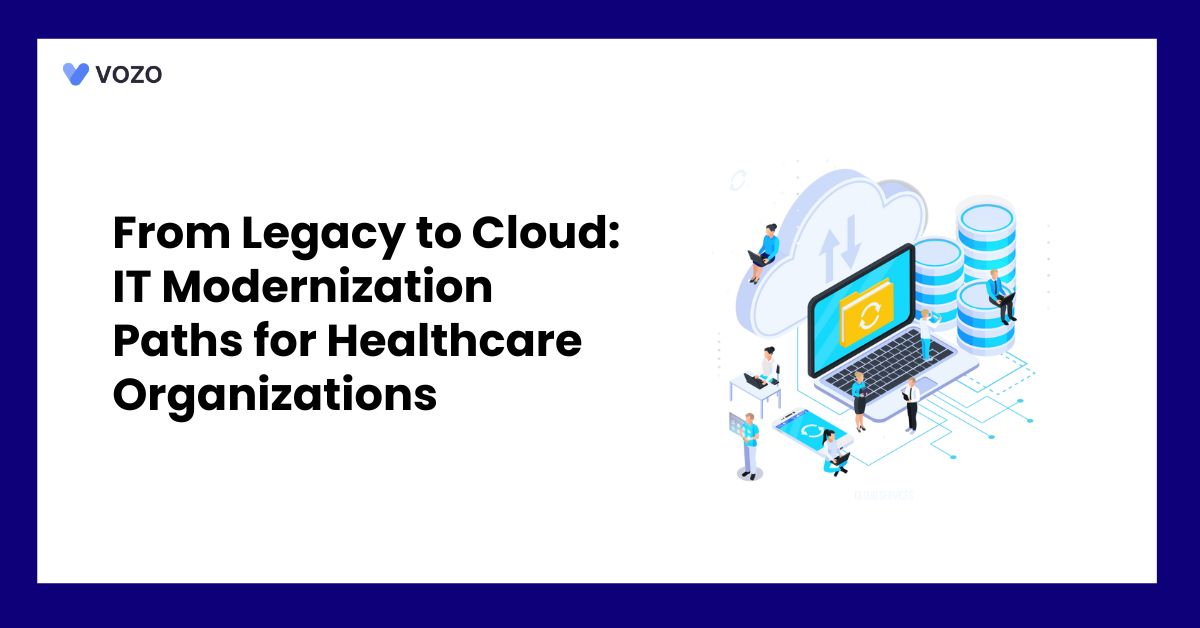From Legacy to Cloud: IT Modernization Paths for Healthcare Organizations
The global shift is toward modern technologies; however, according to the HIMSS survey, 73% of healthcare providers still rely on outdated systems. Legacy systems have outdated software and costly maintenance, which may lead to security risks.
In this blog, you will learn about the drawbacks of legacy IT systems, steps to IT modernization paths, and cloud adoption strategies.
Understanding Legacy and Cloud Healthcare Systems
A legacy system refers to systems using outdated software or hardware, rather than an organization that relies on critical functions. It is difficult to integrate with new technologies and have limited functions with poor user interfaces. Legacy systems have vulnerability issues, which can lead to security breaches owing to expired security mechanisms.
- Older EHRs lack modern functionalities such as interoperability, user-friendly interfaces, as in modern EHRs.
- The legacy HMS system in healthcare may struggle to access real-time data and modern reporting capabilities.
- Older LIS systems have limited integration with other systems and do not support modern laboratory techniques.
- Legacy PACS have limited storage space, and image processing time is slow, and difficult to share medical images. RIS lacks advanced scheduling and modern integration features.
- Outdated systems do not match the modern billing rules and delay claim processing, leading to errors.
- Legacy telehealth requires frequent upgrades for secure communication.
Cloud-based EHR system in healthcare uses internet-based servers to store, manage, and process patient data, medical files, and other health information. The cloud provides flexibility and accessibility, enabling healthcare providers and patients to access data from any location with an internet connection.
Drawbacks of Legacy Systems in Healthcare
1. Delay in Patient Care
Legacy systems in healthcare operate in data silos which affect the flow. This delays the diagnosis process, treatment plans, and patient care. The lab system is not compatible with modern equipment, which slows down the delivery of test results.
2. Data Management
Data accessibility issues and data integration lead to scattered patient records, and providers find it hard to get the patient’s status. Legacy radiology information systems cannot manage large imaging files and slow down the diagnosis process.
3. Compliance and Security Risks
Healthcare is subject to strict regulations to secure patient data, such as HIPAA, but legacy systems lack the necessary controls, which leads to exploitation. Systems with outdated security features are easily vulnerable to data breaches, which results in security risks.
4. Cost and Resources
Maintenance costs of legacy systems are costly and require intensive resources. This requires a lot of funds and is difficult to adapt to new technologies that enhance healthcare services.
5. Outdated User Interfaces
Legacy systems do not have user-friendly interfaces, which may cause users to get irritated. This improves the overall efficiency and integrity of the system.
Related: Cloud EHR vs On-Premises EHR: The Ultimate Comparison
Steps to Cloud Modernization Strategies
1. Assessment and Planning
Conduct a thorough examination of existing infrastructure, inventory of applications, and data to detect technical debt and compliance issues.
2. Strategy and Stakeholder Engagement
Create a goal-oriented plan with clinical, IT, and executive stakeholders to gain buy-in and identify objectives. Set a clear strategy for the organization’s needs and prioritize methods.
3. Choose Modernization Method
Select an appropriate modernization strategy suitable for your healthcare organization. Common methods include the 5Rs, such as Rehost, Refactor, Re-Architect, Rebuild, and Replace.
4. Data Migration
Create a plan for data migration, detailing the steps, timelines, and resources required for the data transfer process. Use ETL pipelines and middleware for gradual migration to reduce downtime and maintain data integrity. Implement security measures to ensure data privacy post-migration.
5. Testing and validation
Before complete production deployment, do rigorous testing to check the system’s performance, security, and compliance. By validating, the team can identify the areas for improvement and take necessary actions.
6. Continuous Monitoring
After post-deployment, the system needs to be monitored continuously and updated regularly with the new technologies. Refine modernization strategies and best practices based on the feedback and system performance.
An Overview of Strategic Modernization Paths
Modernization paths outline how an application transitions from an on-premises traditional infrastructure to a cloud-based environment. Each path is designed for distinct business and technical objectives.
In healthcare, precise alignment with HIPAA, GDPR, and data sovereignty requirements is crucial, making path selection as important for compliance and patient safety as it is for agility and cost savings.
Related: Overcoming Challenges: Cloud-Based EHR Adoption in Rural Hospitals
Cloud Adoption Models and Strategies
1. Encapsulation
Encapsulation is a low-risk method of integrating legacy clinical or administrative systems into larger cloud healthcare architectures by “wrapping” them in modern APIs or service layers, exposing functionality to new cloud services securely without changing the underlying code.
2. Rehost (Lift-and-Shift)
Rehosting allows for rapid scalability and cost-efficiency for core EHR and billing systems by migrating programs to cloud servers in their current state. This technique is appropriate when a business wants to swiftly eliminate on-premises data centers without a significant reorganization effort.
3. Refactor
Revises and improves current databases without altering outer behavior to use cloud-native services like managed databases or organizing containers, resulting in improved performance and maintainability for modules like patient registration and clinical decision support.
4. Re-Architect
Converts monolithic systems to microservices or event-driven architectures, enabling genuine elasticity, resilience, and fault separation for high-availability telemedicine platforms and real-time analytics.
5. Rebuild
Constructs applications anew using modern languages, frameworks, and cloud-native architectures, enabling sophisticated functionalities such as ML-driven diagnostics, yet requires longer development periods and higher initial costs.
6. Replace
Replace legacy systems with off-the-shelf SaaS or COTS solutions, such as cloud-native EHR platforms or revenue-cycle management services. This eliminates maintenance responsibilities and provides built-in compliance, support, and update roadmaps.
Vozo EHR for your Healthcare Practices
From managing and organizing patient health records digitally to reducing medical errors, it significantly empowers providers to improve healthcare quality.
If you are searching for the best EHR system for your healthcare practice, Vozo EHR can be your go-to choice. Our comprehensive EHR solution lets you focus more on patient care while carrying all the burdens and simplifying them.
- Vozo Cloud EHR’s cost-effective cloud subscription benefits all levels of practice.
- Our feature-rich EHR helps you rectify mistakes efficiently and speed up the process.
- Vozo Specialty EHR resonates with specialty practice needs and requirements.
- Our expert technical team has got you covered 24/7 if any needs arise.
- Our EHR System continues to scale as your healthcare practice grows to improve the user experience.
The Vozo Customized EHR solution benefits your healthcare practice by:
- Streamlining the administrative process
- Improving workflow efficiency
- Reducing proneness to errors
- Managing all the patients’ records in one place
- Offers greater efficiency and cost savings across the board.
Our specialty-specific tools, like scheduling, patient portals, lab integration, cloud hosting, and more, meet your healthcare practice’s specific needs and requirements.
“Embrace Vozo EHR to reduce your burdens and enhance patient care.”
About the author

With more than 4 years of experience in the dynamic healthcare technology landscape, Sid specializes in crafting compelling content on topics including EHR/EMR, patient portals, healthcare automation, remote patient monitoring, and health information exchange. His expertise lies in translating cutting-edge innovations and intricate topics into engaging narratives that resonate with diverse audiences.













